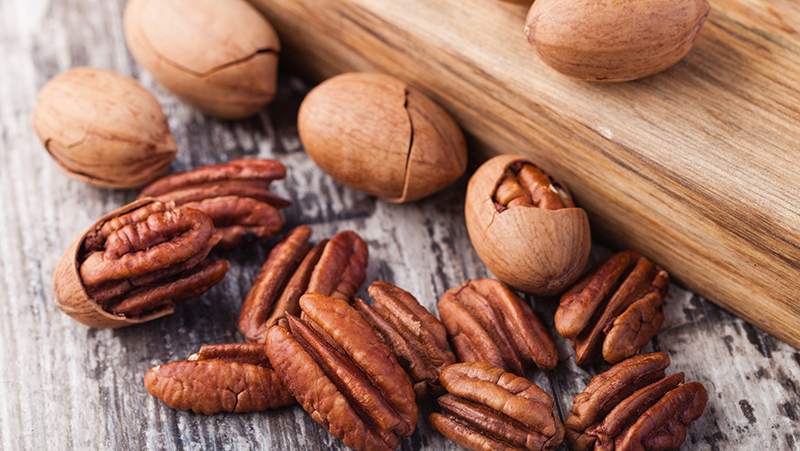Yates Account
Join now
Create a Yates account today!
Sign up to join the Yates Garden Club for monthly e-mails packed with seasonal inspiration, tips for success & exclusive promotions.
Plus if you’re a Garden Club member you can take part in the Yates Growing Community - a blog to share successes, get advice & win prizes in fun challenges along the way!

Forgot password
Enter the email address associated with your account, and we'll email you a new password.

Pecans (Carya illinoinensis) are a gorgeous tree to grow, provided you have the space! They can grow up to 10m tall and make a wonderful shade tree. But the best bit – the nuts! Pecans are delicious raw or roasted and a handful of these nuts a day can actually help reduce your risk of heart disease. They are a long-term investment though, as most varieties bear fruit after 8 years, however, you can find grafted varieties which can produce nuts in 4-5 years.
How to grow Pecans in a garden
- Choose a sunny spot with well drained soil. Enrich the soil with Yates Dynamic Lifter Organic Plant Food and Yates Natures Way Organic Compost & Soil Improver. If the soil is clay based, improve soil structure by adding gypsum and forking in well.
- Dig the planting hole twice as wide and to the same depth as the root-ball. Remove the plant from the container, gently tease the roots and cut away any circled or tangled roots.
- Position in hole and backfill with soil, gently firming down. Form a raised doughnut shaped ring of soil around the outer edge of the plant's root zone. This helps keep water where it's needed. Always water in well after planting to settle the soil around the roots and keep the soil moist for several weeks while the new plant establishes.
- Mulch around the base with organic mulch like woodchip or pea straw, keeping it away from the trunk.
- Water deeply, once or twice a week, depending on weather conditions.
- During the growing and flowering/fruiting season, feed with Yates Thrive Citrus & Fruit Granular Plant Food. TIP: for an added boost during the flowering/fruiting season, apply Yates Thrive Natural Fish & Seaweed+ Plant Food Concentrate.
- Reapply Yates Dynamic Lifter Organic Plant Food and Yates Natures Way Organic Compost & Soil Improver at least once or twice a year to keep the soil nice and rich.

Growing tips
- Pecans grow best in temperate and sub-tropical regions, but can tolerate areas with cold winters. Check plant labels before purchasing.
- Pecans can be divided into two groups, depending on when male and female flowers mature
– Type A (protoandrous): pollen is shed early, before the female flower is ready
- Type B (protogynous): pollen is shed late.
While most varieties are self-pollinating, planting varieties from each group will ensure optimum cross pollination.
More Plants
Lemon trees can grow up to 4m, but you can also get dwarf varieties that only grow to 1.5m which are perfect for small gardens and for pots.
Feijoa
Feijoa trees are a familiar sight in kiwi gardens; they're also a great choice for an edible hedge. The delicious fruit can be eaten fresh; they’re also perfect for using in cakes, muffins, jams, cocktails, desserts, fruit salad and smoothies.
Raspberry
Raspberries are best when they're fresh, and you can’t get any fresher than picking your own! Delicious when eaten raw and in desserts, jam or jelly.
Limes
Lime fruits are known for their delicious juice and zest. A highly flavoursome ingredient used in sweet or savoury dishes and sensational in drinks.
Yates Thrive Citrus & Fruit Granular Plant Food
Fast acting, gradual feeding plant food specially formulated to grow citrus & fruit trees, with high potassium for more abundant fruit & added magnesium to help prevent leaf yellowing.
Yates Thrive Natural Fish & Seaweed+ Plant Food Concentrate
A complete plant food enriched with natural fish, seaweed, humates, molasses and more - boosted with NPK to improve plant and soil vitality.
Yates Nature's Way Organic Compost & Soil Improver
Transform soil into a healthy nutrient-rich base for your gardens and lawns with Yates Nature’s Way Organic Compost & Soil Improver.
Yates Dynamic Lifter Organic Plant Food
Releases nutrients slowly, improves the structure and moisture retention of the soil and encourages earthworms and beneficial soil micro-organisms.
















Share
Share this article on social media